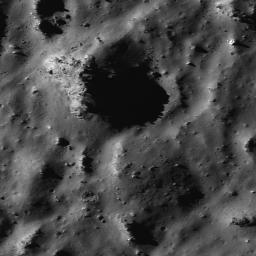
|
Impact Melt Features in Tycho Crater’s Floor
- Click the image above for a larger view
- Full-Res JPEG (1000 x 1000) (123.9 kB)
- Full-Res TIFF (1000 x 1000) (1.0 MB)
Caption:
Depressions and positive relief features in Tycho crater were caused by a complex mixture of granular material and impact melt settling to the floor. Image width is 370 meters (1214 feet), LROC NAC M119923147L.
Impact melt creates a wide variety of features on the Moon. These include melt ponds , draped ejecta , viscous flows , linear and nonlinear depressions, and positive relief features. As impact melts mix with loose rock during crater formation, solid pieces of rock stick above the surface of the ponding melt to form little peaks (positive relief features). The depressions are possibly cooling fractures in the melt that result as the melt slowly solidifies and contracts (the opposite of how water behaves when it freezes), however they could also be part of an impact melt drainage network. We don't know for certain know the origin of all of these features, the best way to find out is to have astronauts traverse this terrain while exploring the Moon.
Background Info:
NASA's Goddard Space Flight Center built and manages the mission for the Exploration Systems Mission Directorate at NASA Headquarters in Washington. The Lunar Reconnaissance Orbiter Camera was designed to acquire data for landing site certification and to conduct polar illumination studies and global mapping. Operated by Arizona State University, LROC consists of a pair of narrow-angle cameras (NAC) and a single wide-angle camera (WAC). The mission is expected to return over 70 terabytes of image data.
Cataloging Keywords:
| Name | Value | Additional Values |
|---|---|---|
| Target | Moon | |
| System | Earth | |
| Target Type | Satellite | |
| Mission | Lunar Reconnaissance Orbiter (LRO) | |
| Instrument Host | Lunar Reconnaissance Orbiter | |
| Host Type | Orbiter | |
| Instrument | Lunar Reconnaissance Orbiter Camera (NAC) | |
| Detector | Narrow Angle Camera (NAC), Wide Angle Camera (WAC) | |
| Extra Keywords | Crater, Grayscale, Impact, Water | |
| Acquisition Date | ||
| Release Date | 2010-12-10 | |
| Date in Caption | ||
| Image Credit | NASA/GSFC/Arizona State University | |
| Source | photojournal.jpl.nasa.gov/catalog/PIA13501 | |
| Identifier | PIA13501 | |
